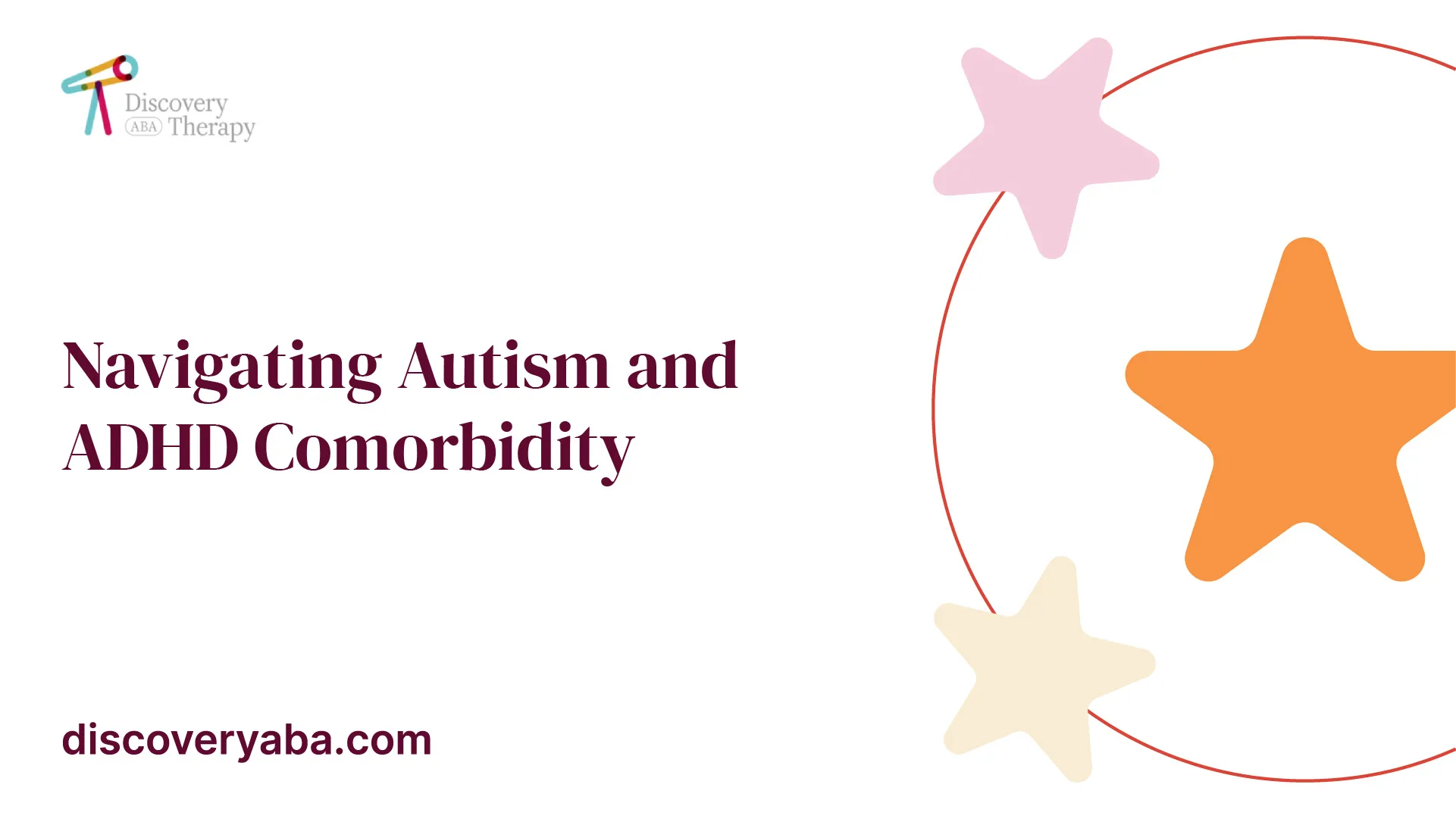Navigating Autism and ADHD Comorbidity
Unraveling the complexities of autism and ADHD comorbidity. Explore the overlap, impact, and treatment approaches for this dual diagnosis.

Understanding Autism and ADHD
To comprehend the comorbidity of autism and ADHD, it is essential to gain a clear understanding of each condition individually.
What is Autism Spectrum Disorder (ASD)?
Autism Spectrum Disorder (ASD) is a neurodevelopmental disorder characterized by persistent difficulties in social communication and interaction, as well as restricted and repetitive patterns of behavior, interests, or activities. Individuals with ASD may have challenges with social interactions, communication, sensory sensitivities, and restricted patterns of interests and behaviors.

What is Attention Deficit Hyperactivity Disorder (ADHD)?
Attention Deficit Hyperactivity Disorder (ADHD) is a neurodevelopmental disorder characterized by symptoms of inattention, hyperactivity, and impulsivity. Individuals with ADHD often struggle with maintaining attention, organizing tasks, and managing impulsive behaviors.
The Prevalence of Autism and ADHD Comorbidity
Research indicates a high level of comorbidity between autism and ADHD. According to scientific literature, approximately 50 to 70% of individuals with autism spectrum disorder (ASD) also present with comorbid attention deficit hyperactivity disorder (ADHD). The prevalence of ADHD in people with ASD ranges from 50 to 70% as well.
A study published by the Journal of the American Academy of Child & Adolescent Psychiatry in 2019 found that ADHD is present in 30-80% of individuals with ASD, while ASD presents in 20-50% of individuals with ADHD. This indicates a significant level of comorbidity between these two conditions.
It's important to note that individuals can experience symptoms of another disorder even without an official diagnosis, known as "below-threshold cross-disorder symptoms." Among individuals with autism, ADHD is more prevalent compared to almost any other condition.
Understanding the individual characteristics and prevalence of autism spectrum disorder (ASD) and attention deficit hyperactivity disorder (ADHD) lays the groundwork for exploring their comorbidity and the impact it can have on individuals' lives.
Overlapping Symptoms and Characteristics
When considering the comorbidity of Autism Spectrum Disorder (ASD) and Attention Deficit Hyperactivity Disorder (ADHD), it's important to examine the similarities and differences between these two neurodevelopmental conditions. Additionally, exploring the shared genetic factors and neurobiological substrates can provide insights into the underlying mechanisms of comorbidity.
Similarities Between Autism and ADHD
Autism and ADHD share certain behavioral and cognitive characteristics. One of the key similarities is social difficulties. Both individuals with ADHD and those with autism often experience challenges in social interactions and forming meaningful relationships. Children with ADHD may struggle with social problems, leading to peer rejection and reduced friendships, even though social difficulties are not part of the core diagnostic criteria for ADHD.
Attentional impairments are another area of overlap. Individuals with ADHD may exhibit symptoms such as short attention span and excessive distractibility, while those with autism tend to experience difficulties with shifting focus and not listening. These attentional impairments can impact daily functioning and academic performance in both conditions.
Differences Between Autism and ADHD
Although there are similarities, there are also distinct differences between autism and ADHD. Autism is characterized by impaired social communication and interaction, restricted and repetitive behaviors, and challenges in social-emotional reciprocity. In contrast, ADHD is primarily characterized by symptoms of inattention, hyperactivity, and impulsivity [2].
It's important to note that the presentation of symptoms can vary among individuals, making the diagnosis and differentiation between the two conditions challenging. Additionally, individuals can exhibit symptoms of the other disorder, even without an official diagnosis, which is known as below-threshold cross-disorder symptoms.
Shared Genetic Factors and Neurobiological Substrates
Research suggests that autism and ADHD have shared genetic influences. A genome-wide case-control study found that many genetic copy number variants (CNVs) contribute to the risk of both ADHD and ASD. Furthermore, individuals with ADHD and their siblings tend to exhibit more symptoms associated with ASD compared to individuals without siblings, suggesting a shared genetic contribution.
Neurobiologically, both autism and ADHD are associated with similar underlying deficits. These include abnormalities in brain structure, connectivity, and neurotransmitter systems. However, further research is needed to fully understand the specific neurobiological substrates that contribute to the comorbidity of autism and ADHD.
Understanding the overlapping symptoms, differences, and shared genetic factors between autism and ADHD is crucial for accurate diagnosis and effective treatment approaches. By recognizing these complexities, healthcare professionals can provide comprehensive support and interventions tailored to the individual's specific needs.
Diagnosis and Assessment
When it comes to diagnosing and assessing the comorbidity of autism and ADHD, there are specific challenges that medical professionals encounter. However, with the recognition that many children can meet the criteria for both conditions, diagnosis and assessment have evolved to accommodate this comorbidity.
Challenges in Diagnosing Autism and ADHD Together
Prior to 2013, the American Psychiatric Association (APA) criteria did not allow doctors to diagnose individuals with both autism and ADHD simultaneously. However, since then, medical professionals recognize that many children can meet the criteria for both conditions. Diagnosing autism and ADHD together can be challenging due to overlapping symptoms and the need to differentiate between the two conditions.
Doctors rely on information from teachers, caregivers, and parents to gather comprehensive insights into a child's behavior and development over previous years. This longitudinal assessment helps in identifying patterns and determining the presence of both autism and ADHD. It is crucial to consider the child's history and symptoms present in the past six months to make an accurate diagnosis of ADHD. If there are suspicions of autism, a broader assessment of the child's behavior and development is necessary.
Assessment Tools for Autism and ADHD
Medical professionals employ various assessment tools to diagnose and assess the comorbidity of autism and ADHD. These tools help in evaluating the presence of symptoms and identifying the severity of each condition. Some commonly used assessment tools include:
- Autism Diagnostic Observation Schedule (ADOS): ADOS is a structured observation assessment that evaluates communication, social interaction, and play in individuals suspected of having autism. It provides valuable insights into the presence and severity of autism symptoms.
- Autism Diagnostic Interview-Revised (ADI-R): ADI-R is a comprehensive interview-based assessment conducted with caregivers or parents. It focuses on gathering detailed information about the individual's developmental history and current behaviors related to autism.
- Conners' Rating Scales: Conners' Rating Scales are widely used for assessing ADHD symptoms. They consist of questionnaires completed by parents, teachers, and individuals themselves, providing a multi-perspective evaluation of ADHD symptoms.
- Vanderbilt Assessment Scales: The Vanderbilt Assessment Scales are another set of questionnaires used to assess ADHD symptoms. They are completed by parents, teachers, and sometimes the individuals themselves, offering a comprehensive evaluation of ADHD-related behaviors.
By utilizing these assessment tools, medical professionals can gather comprehensive information to make an accurate diagnosis and understand the individual's unique profile of symptoms. This enables them to develop appropriate treatment plans tailored to the specific needs of individuals with comorbid autism and ADHD.
Diagnosing and assessing the comorbidity of autism and ADHD requires careful consideration of overlapping symptoms and the use of reliable assessment tools. By addressing the challenges and employing appropriate assessment methods, medical professionals can provide accurate diagnoses and develop effective treatment strategies for individuals with this comorbidity.
Impact and Implications of Comorbidity
When autism spectrum disorder (ASD) and attention deficit hyperactivity disorder (ADHD) coexist, it can have a significant impact on daily life and functioning. The comorbidity of these two conditions presents unique challenges and considerations. Let's explore the impact on daily life and the treatment approaches for individuals with co-occurring autism and ADHD.
The Impact on Daily Life and Functioning
According to a study published by the Journal of the American Academy of Child & Adolescent Psychiatry, ADHD is present in 30–80% of individuals with ASD, and ASD presents in 20–50% of individuals with ADHD, indicating a high level of comorbidity between autism and ADHD. The co-occurrence of these conditions is associated with greater impairment in daily life, lower cognitive functioning, more severe social impairment, and greater delays in adaptive functioning compared to ASD alone.
Children with ADHD often experience significant social difficulties, which can lead to peer rejection and fewer friendships. Social problems, although not part of the core diagnostic criteria for ADHD, are common and impactful. The combination of symptoms from both conditions can result in challenges in various areas, including communication, executive functioning, attention, and behavior management. These difficulties can affect academic performance, relationships, and overall quality of life.
Treatment Approaches for Co-occurring Autism and ADHD
Treating individuals with co-occurring autism and ADHD requires a comprehensive approach that addresses the symptoms of both conditions. Medication may be prescribed to manage the symptoms of ADHD and can also help alleviate some symptoms of ASD in individuals diagnosed with both conditions. However, it's important to note that medication alone may not be sufficient in managing the complex needs associated with ASD and ADHD.
Behavioral therapies and interventions play a crucial role in the treatment of co-occurring autism and ADHD. Early intervention is particularly important, as studies have shown that children who receive appropriate support at a younger age tend to experience more favorable outcomes in terms of their social and adaptive behavior. Personalized treatments that focus on social learning theory and address the individual's unique needs can be beneficial in managing symptoms of both disorders [2].
It's essential to develop an individualized treatment plan in collaboration with healthcare professionals, considering the specific strengths, challenges, and goals of the person with co-occurring autism and ADHD. This may involve a combination of behavioral therapies, educational support, social skills training, occupational therapy, and parent training programs.
Ongoing research is being conducted to better understand the connection between autism and ADHD and to develop more effective treatments for individuals with comorbid conditions. By addressing the unique needs of individuals with co-occurring autism and ADHD through a comprehensive approach, it is possible to improve daily functioning, enhance quality of life, and support individuals in reaching their full potential.
Managing Autism and ADHD Together
When it comes to managing the co-occurrence of autism and ADHD, a comprehensive approach that combines medication and behavioral therapies is often recommended. This dual approach aims to address the unique challenges and symptoms associated with both disorders.
Medication for Symptom Management
Medication can play a role in managing the symptoms of both autism and ADHD. While there is no specific medication that can treat the core symptoms of autism, certain medications prescribed for ADHD may also help manage some symptoms of autism in individuals diagnosed with both conditions. It's important to note that medication response can vary among individuals, and close collaboration with healthcare professionals is vital to finding the most appropriate medication and dosage for each individual.
Behavioral Therapies and Interventions
Behavioral therapies and interventions are key components in managing the co-occurrence of autism and ADHD. These therapeutic approaches can help individuals develop coping skills, improve social interactions, and enhance overall functioning. Here are some commonly used behavioral therapies and interventions:
- Social Skills Training: This type of therapy focuses on teaching individuals with autism and ADHD the necessary skills to navigate social situations effectively. It may involve role-playing, modeling, and practice scenarios to improve social interactions and communication.
- Cognitive-Behavioral Therapy (CBT): CBT is often used to address emotional and behavioral challenges associated with both disorders. It helps individuals identify and change negative thought patterns, manage emotions, and develop effective problem-solving strategies.
- Parent Training: Parent training programs provide parents and caregivers with strategies to support their child's development and manage challenging behaviors. These programs typically focus on behavior management techniques, communication strategies, and creating a supportive home environment.
- Educational Interventions: Tailored educational interventions are essential for individuals with autism and ADHD. These interventions may involve individualized learning plans, accommodations, and supports to address specific learning needs and optimize academic success.
A personalized approach is often necessary to address the unique needs of each individual. It's crucial to involve a multidisciplinary team, including healthcare professionals, educators, and therapists, to develop a comprehensive treatment plan that considers the specific strengths and challenges of the individual.
By combining medication for symptom management and implementing appropriate behavioral therapies and interventions, individuals with both autism and ADHD can receive comprehensive support to optimize their daily functioning and overall well-being. Early intervention, tailored treatment plans, and ongoing monitoring are key factors in helping individuals navigate the challenges associated with comorbid autism and ADHD [2].
Research and Future Directions
As our understanding of autism and ADHD continues to evolve, ongoing research is being conducted to explore the comorbidity between these two conditions and deepen our understanding of their connection.
Ongoing Research on Autism and ADHD Comorbidity
Research has shown a high level of comorbidity between autism spectrum disorder (ASD) and attention deficit hyperactivity disorder (ADHD). According to a study published in the Journal of the American Academy of Child & Adolescent Psychiatry, ADHD is present in 30–80% of individuals with ASD, and ASD presents in 20–50% of individuals with ADHD. This indicates a significant overlap between the two conditions.
Ongoing research focuses on exploring the underlying genetic and neurobiological factors that contribute to the comorbidity between autism and ADHD. Studies have indicated that shared genetic influences play a role in the similarities in behavior observed in both disorders. Genetic copy number variants (CNVs) have been identified as contributing risks for both ADHD and ASD.
Understanding the connection between autism and ADHD is essential for improving diagnostic accuracy and developing targeted interventions. Research aims to identify the specific factors that contribute to the overlap in symptoms and characteristics between these two conditions. By doing so, researchers hope to enhance our ability to identify individuals who have both autism and ADHD, leading to more personalized and effective treatment approaches.
Understanding the Connection Between Autism and ADHD
The overlap in symptoms and characteristics between autism and ADHD has been a focus of research. Both conditions share similarities, such as social problems, which can have a significant impact on individuals. Children with ADHD often experience social difficulties, leading to peer rejection and fewer friendships, despite social problems not being part of the core diagnostic criteria for ADHD.
Treatment approaches for individuals with co-occurring autism and ADHD often involve a combination of medication and psychosocial interventions. Studies have shown that more children with ADHD respond well to certain treatments compared to those with autism. Personalized treatments based on social learning theory may be beneficial for managing symptoms of both disorders.
As research continues, it is anticipated that further insights will be gained into the complex relationship between autism and ADHD. This will contribute to the development of more targeted and effective interventions, improving the quality of life for individuals with comorbid autism and ADHD.
By advancing our understanding of the comorbidity between autism and ADHD, researchers and healthcare professionals can provide better support and interventions for individuals who experience the challenges associated with both conditions. Ongoing research holds the promise of improving diagnostic accuracy, treatment approaches, and ultimately enhancing the lives of those affected by the dynamic duo of autism and ADHD.
References
- https://www.ncbi.nlm.nih.gov/pmc/articles/PMC8918663/
- https://www.autismparentingmagazine.com/learn-autism-differences/
- https://psychscenehub.com/psychinsights/adhd-and-autism-comorbidity-a-comprehensive-review/
- https://www.medicalnewstoday.com/articles/325618
- https://www.ncbi.nlm.nih.gov/pmc/articles/PMC4010758/
- https://chadd.org/attention-article/understanding-and-differentiating-between-autism-and-adhd/
- https://www.focusbear.io/blog-post/diagnosed-with-both-adhd-and-autism-overcoming-obstacles
Does Your Child Have An Autism Diagnosis?
Learn More About How ABA Therapy Can Help
Find More Articles
Contact us
North Carolina, Nevada, Utah, Virginia
New Hampshire, Maine
Arizona, Colorado, Georgia, New Mexico, Oklahoma, Texas
.avif)


































































































